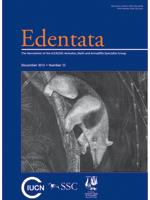The giant anteater (Myrmecophaga tridactyla) is one of the most distinctive animals of South America. In northern Argentina it is found in forests, savannahs, and grasslands. It is listed as Vulnerable in the IUCN Red List of Threatened Species. The present study was conceived as a husbandry tool for individuals of this species in zoos. The research was developed at CRET (Temaikèn Center of Species Reproduction) and consisted in elaborating the behavioral repertoire of a group of three adult females from April 2009 to April 2010. A total of 122 h of behavioral observations were made by the naked eye at a distance of 1–5 m through a metallic mesh, five times a week, with focal animal ad libitum sampling from 9:00 to 18:00 hr. A diagram of the exhibit was confected to ease the data collecting process. To facilitate the description of the behavioral acts, an identification of the different physical characteristics of each individual was conducted along with the segmentation of the body. During the 12 months of observations, 38 behavioral acts were defined, which were then grouped into eleven categories. Finalization of data collection was based on the saturation curve; the first asymptote was reached at 35 h, while the final one, which remained constant, was reached at 52 h and contained the 38 behavioral acts registered in the ethogram.
How to translate text using browser tools
1 December 2012
Ethogram of the Giant Anteater (Myrmecophaga tridactyla) in Captivity: An Experience in the Temaikèn Foundation
Tamara Leticia Schmidt

Edentata
Vol. 13 • No. 1
December 2012
Vol. 13 • No. 1
December 2012
behavior
captivity
cautiverio
comportamiento
ethogram
etograma
giant anteater




